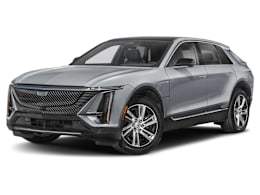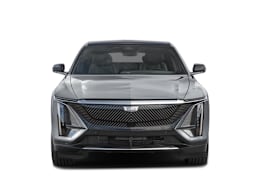Despite pioneering work by General Motors with the early EV1 and Chevrolet Volt, and later the Cadillac ELR and Chevrolet Bolt, the Cadillac brand finds itself rather late to jump on the EV bandwagon. But now the all-new Lyriq is here, Cadillac’s first fully electric vehicle. It showcases next-generation styling for the brand, and introduces a new modular electric platform, called Ultium, that is shared with the Chevrolet Blazer (which we’ve also tested) and Equinox EVs, as well as the Acura ZDX and Honda Prologue.
The Lyriq is roughly the length and width of Cadillac’s XT6 SUV. However, the Lyriq has a much sleeker profile, being 6 inches lower and riding on a 9-inch longer wheelbase.
The Lyriq’s quick and quiet acceleration, athletic handling, comfortable ride, and relatively speedy home charging make it a compelling choice. Also helping its cause is its predicted 300-plus miles of driving range on a full charge, which means you’ll likely be able to go for days without recharging. The cabin is nicely designed with an understated yet high-tech look, and it’s chock full of top-notch materials.
Unfortunately, several of the Lyriq’s controls are a bit less than “user-friendly,” including the infotainment system’s controller knob and some of the seat-related functions located on the door. And, despite its competitively high road-test score, we can’t recommend the Lyriq yet because we lack reliability data on General Motors’ new EV platform.
We bought a Cadillac Lyriq Luxury 2 AWD—anonymously from an area dealer, as we do with every vehicle we test—for the purpose of this road test review.
Driving experience
The Lyriq comes with either rear- or all-wheel drive, producing 340 horsepower and 500 hp, respectively, and both versions rely on a large, 102-kilowatt-hour battery. The EPA estimates that the rear-wheel-drive model has 314 miles of driving range and the all-wheel drive has a 307-mile range. Our tested AWD model notched an impressive 315 miles in our 70-mph highway range test.
With a super-smooth 500 hp from its dual electric motors (which give it all-wheel drive), the Lyriq’s power is effortless and abundant. It gathers speed rapidly, but in a measured and proportional way that’s gratifying to experience. If you press the accelerator pedal all the way to the floor, the Lyriq can catapult from 0 to 60 mph in just 5.1 seconds.
Home charging can be relatively quick if using a 100-amp circuit, thanks to the Lyriq's optional 19.2-kilowatt onboard charger. A maximum acceptance rate of 190 kW at public DC fast-charging locations is also competitive.
We appreciate how easy Cadillac makes it to turn the Lyriq’s “one-pedal driving” (in which you control the car’s acceleration and braking with just the accelerator pedal) on or off by pressing an icon on the infotainment screen. It also has a novel way that you can apply on-demand regenerative-braking (without being in one-pedal mode) by pulling and holding a paddle on the steering wheel, allowing you to modulate the force similar to a hand brake on a bicycle.
As with other modern Cadillacs, the Lyriq is adept at taking corners, revealing some athletic chops when driven on challenging backroads. The steering has an appropriate heft (meaning not too heavy, not too light) and body roll through corners is nicely controlled during normal to slightly-pushing-it driving. The taut, responsive nature it possesses makes the Lyriq enjoyable to drive, with the one downside that the steering is short on feedback to the driver about road texture and tire grip. While the ride isn’t plush, we found the suspension to be mostly supple and absorbent, and it does a nice job keeping the car composed over mid-corner bumps. Still, rougher roads show its limitations, and the firm suspension along with the large 20-inch tires do allow the occasional abrupt impact to punch through into the cabin.
Cabin comfort
The plush and understated cabin is super quiet and filled with luxury touches such as matte wood, brushed chrome, exposed stitching, padded touch points, and nicely-lined storage bins.
Our drivers found the front seats comfortable but the bottom cushion could use more pronounced side bolsters. Even though the Lyriq is a pretty low-slung SUV, most drivers will find it roomy and well-sorted with lots of adjustments. There’s a decent view out over the hood, aided by the low dashboard and instrument-panel screen, along with plenty of headroom and zero intrusion for the driver’s right knee thanks to the “floating” center console.
There’s a lot of knee room and good foot space in the rear seat, though comfort is compromised by the protruding anchors for child car seats that poke into passengers’ lower backs. Getting in and out is easy thanks to the Lyriq’s in-between height; it’s neither as tall as an SUV nor as low as a sedan. It’s just a shame that the thin door handles don’t pop up quickly enough and are awkward to grasp. There’s no question that the Lyriq looks distinctive, but one of the tradeoffs for its flashy styling is very limited side- and rear outward visibility. The back window is also rather small, and there isn’t a rear wiper.
Controls and usability
The Lyriq’s 33-inch dashboard screen is impressive looking. It allows interactions through either touch or by using a center controller knob on the console, and it has Google maps and voice assistant built-in. Overall the controls are less complicated than some other luxury brands’ layouts, but a few aspects are a bit annoying. Multiple drivers said that the infotainment system’s rotary controller dial is unintuitive to use, so they opted for the touchscreen on the dashboard instead. The heated/cooled seat buttons are located in an awkward position on the door panel, and the lumbar-support and massage knob on the door is thoroughly confusing to use. All that said, we definitely appreciate the manual climate controls—as opposed to the touch-capacitive “buttons”' on a panel that we’re seeing in so many vehicles these days.
Safety
Standard active safety and driver assistance features include automatic emergency braking with pedestrian and cyclist detection, automatic emergency braking that operates at highway speeds, blind spot warning, rear cross traffic warning, reverse automatic emergency braking, lane departure warning, lane keeping assistance, and automatic high beams. Adaptive cruise control is optional on the base Tech trim, though standard on the Luxury and Sport.
The mid-level Luxury 2 trim we purchased has the latest version of General Motors’ Super Cruise, which is one of the best active driving assistance systems. It can handle acceleration, braking, and steering on pre-mapped highways as well as some two-lane roads. It has a direct driver monitoring system that’s neither too intrusive nor too lax, providing a comfortable and confident hands-off (but eyes-on!) experience. The system can also execute lane changes seamlessly on its own. A free 3-year trial is included.


























